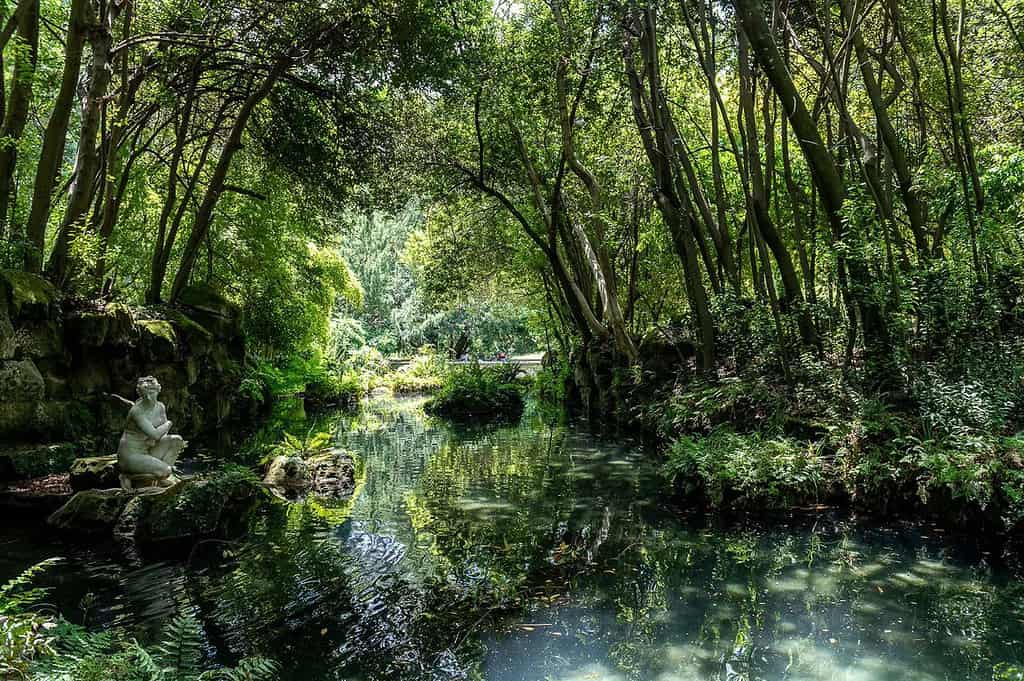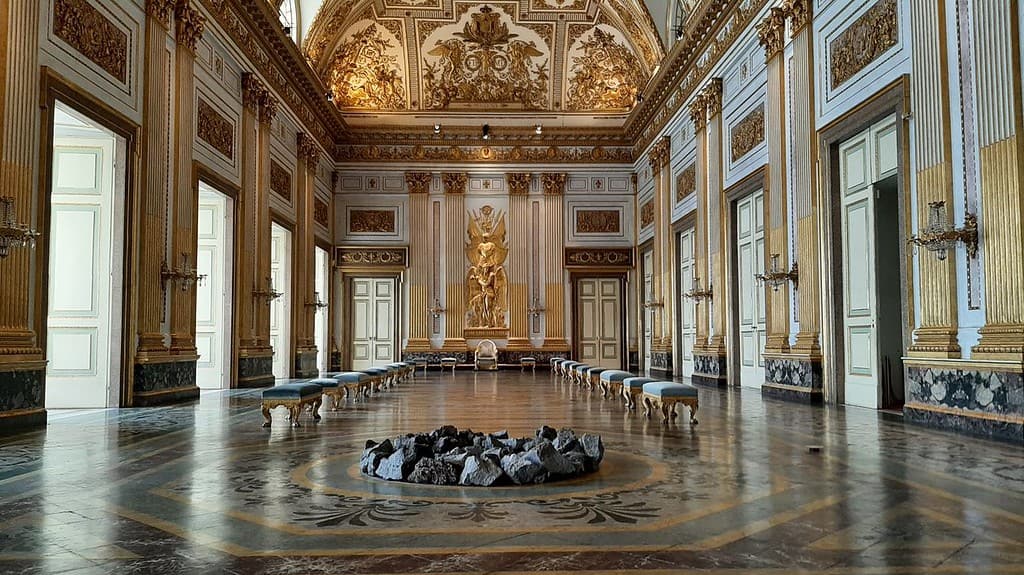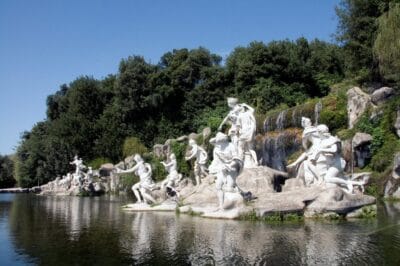From July 1 to October 16, the grand multifaceted royal residence, a Ebe ihe nketa UNESCO, will be hosting an exhibition entitled Fragments of Paradise, Gardens at the time of the Reggia di Caserta, curated by Reggia di Caserta Director Tiziana Maffei, Alberta Campitelli and Alessandro Cremona.
In the rooms of the Queen’s Apartment overlooking the incomparably beautiful view of the Royal Park with its theatrical waterworks, will be celebrated as the most complete and best-preserved of the residences that Charles de Bourbon, King of Naples from 1734, and his wife, Maria Amalia of Saxony, commissioned to display their power and their sophisticated cosmopolitan culture in an exhibition whose innovative format combines scientific research with a feel for the spectacular.
Approximately 200 exhibits including paintings, drawings, sculptures, herbaria, books, and objets d’art along with coeval depictions and representations tell the story of the garden with themes and stories taking their cue from the Reggia di Caserta to bring into play and relate whole systems of villas and gardens crisscrossing and involving the entire peninsula from the Renaissance to the early 19th century. The result is a kaleidoscope of representations that, in the diversity of their landscapes, cultural models, and lifestyles, through contact with nature, conjure up the lost Garden of Eden to which man has aspired since time immemorial.
“Historical parks and gardens are a part of Europe’s deepest cultural identity.”
Tiziana Maffei added: “And the role of Italy’s skill with the landscape in the past is beyond question, but today, at long last, we are acquiring a full awareness of this. The decision to devote a specific portion of the PNRR funding to the restoration and management of these wonderful sites offers us the opportunity to take responsible care of this heritage, as precious as it is fragile.
“The exhibition at the Reggia di Caserta, the product of demanding research that has involved the cooperation of numerous national institutions and scholars, sets out to illustrate, for both experts and a broader audience, the different values concealed behind these minor representations of Paradise while also shining the spotlight on the urgent need to safeguard them in order to ensure their full accessibility and the opportunity to hand their beauty down to future generations.”
Focusing on various aspects of the history of the Reggia di Caserta’s Royal Park, this rich exhibition also reviews the history of the “garden” as such.

A constant feature of man’s imagination down the centuries and across different civilizations, the concept has spawned a broad variety of models. The formal design of gardens in the Italian or French styles, or the more laissez-faire style of English gardens, in parallel with the development of botanical science, reflect the different cultural contexts that expressed them.
“In creating gardens,” explained Alberta Campitelli, “people sought to exorcise the idea that nature was dark and menacing. The harmonious controlled and organized space of a garden is a microcosm dominated by man and evocative of the Garden of Eden.
“Several themes cross in the garden: the garden is a narrative mediated by symbols; it is a journey of discovery; it is the transmission of messages; it is a scientific experiment; it is a living creature that is born, changes and disappears.
“Being depicted in a painting lends it immortality, crystallizing a moment of splendor and celebrating its patron. In the dazzling kaleidoscope of images that make up the exhibition, visitors enter this fascinating world in which each one can find his or her own individual paradise.”

The immense Museo Verde del Complesso Vanvitelliano, (green museum of the Vanvitellian complex) boasts a park covering 123 hectares, 60 of which are forest, and roughly 40 km worth of aqueducts built starting in 1752 to an initial design by Luigi Vanvitelli as an open space connected to the Royal Palace intended to dazzle the world. It ideally links the cultural references of Charles of Bourbon with those of his celebrated great grandfather Louis XIV and the universal model of Versailles, with his highly sophisticated mother Elisabetta Farnese and with the northern European influence of his wife Maria Amalia of Saxony.
This astonishing design was further enriched half a century later with the innovative and mesmerizing English Garden commissioned by Maria Carolina of Lorraine. It combines the scenographic setting of the water and fountains with the balanced addition to the unique rustic and marine landscape of the majestic presence of Mount Vesuvius, thus becoming the ideal venue for illustrating the extent to which the garden is one of the most fascinating and fragile elements of Europe’s, and especially of Italy’s, cultural identity.
“On entering the park of the Reggia di Caserta,” remarked Alessandro Cremona, “one is immersed in every single one of the meanings with which the Western garden, and the Italian garden, in particular, are imbued. The relationship with the “residence” and with the surrounding landscape, the recreational and utilitarian purposes, the celebratory and sumptuary aims, and the sense of perception and taste between formal design and a more ‘English style’ of the landscape. The exhibition leads visitors through this extraordinary complexity, wending its way through the heavenly labyrinth of the painted and imagined garden, prompting visitors to “take delight” in the vision of Vanvitelli’s splendid gardens.”
The various sections each contain numerous works, many of them never seen in public before, from prestigious Italian and European museums and institutions, private collections, libraries, and other public institutes. The many artists celebrated include geniuses of the caliber of Gaspar van Wittel, Claude Lorrain, Paolo Anesi, Pietro and Gianlorenzo Bernini, Hubert Robert, Hendrick van Cleve III, Jules-César-Denis van Loo, Giusto Utens, Joseph Heintz the younger and other famous vedutisti, with a leading role being played, quite naturally, by Jacob Philipp Hackert who devoted so much of his work to gardens and landscapes in Campania and southern Italy.

The sections develop themes that take their cue from the Reggia di Caserta and its history, juxtaposing and comparing it with the results of other commissions and other contexts:
– the Reggia di Caserta and its models, with the celebrated depictions of the Reggia di Caserta’s Royal Park set alongside those of the gardens which Charles and Maria Amalia knew and loved in their countries of origin and which helped to shape their taste;
– the garden and the landscape, a relationship highlighted in the views of well-known gardens stretching from Campania to Lazio, the Marche, Tuscany, and Piedmont, painted by the greatest artists of the various periods involved;
– the garden as stage set illustrates the extent to which the display of power, festivities, and theatricals have always had gardens as their setting of choice, adapted to cater to the specific functions hosted;
– water and gardens where water is the spectacular protagonist of waterworks, fountains, and waterways, while also offering a much-loved view of lakes, rivers, and the sea;
– the garden and the wilderness are a tribute to the forests and estates that complemented the villas and gardens, stretching from the tradition of Medici gardens right up to the 19th century;
– the garden as a setting for religious and mythological narratives, from the depiction of Christ “the gardener” via mythological and literary episodes and up to and including the allegories of the seasons, such as those of Pietro and Gianlorenzo Bernini;
– botanicals in the garden, the plant element as the protagonist with different roles and functions such as, for example, “tulipomania” or the introduction of exotic plants and the popularity of botanical science.
The exhibition’s spectacular impact is due to the numerous works of art displayed around each intriguing theme. But primarily, it is based on in-depth scholarly and scientific research with contributions from highly authoritative scholars and experts, offering a reflection on a part of our heritage that is of crucial importance at this particular moment in man’s history. This, is because today possibly more than ever before, the institutions are promoting initiatives for the conservation and enhancement of historical gardens in terms both of their intrinsic cultural value and their importance as vehicles for social welfare, thanks to the earmarking of considerable funds for their restoration and management. In parallel, the need for specific, targeted training in that connection is also now broadly recognized.

With this contribution to knowledge transmitted thanks (also) to the charm of such a peerless venue as the Reggia di Caserta, we aim to promote a greater awareness of the importance and the value of this heritage, as fragile as it is precious, that so nobly and elegantly encapsulates the product of man’s harmonious interaction with nature.
The exhibition also provides us with an opportunity to experiment with contemporary technology thanks to our technical partner the Kainon Foundation, with the virtual reconstruction of the first part of the garden designed by Luigi Vanvitelli in the celebrated Declaration of Drawings and the punctuation of contemporary artists freely interpreting the concept of the garden as a potential Paradise.
The exhibition, organized by the Museo Della Reggia di Caserta in conjunction with Opera Laboratori, benefits from a prestigious international scholarly advisory board and from the crucial contribution of the Orti Botanici di Napoli e Portici.
The event is produced in partnership with the Camera di Commercio di Caserta and with the support of the Amici della Reggia di Caserta, Colonnese&Friends, Associazione Parchi e Giardini d’Italia, Grandi Giardini Italiani and the European Route of Historic gardens.
IHE Ị GA-Ewepụ na edemede a:
- In the rooms of the Queen's Apartment overlooking the incomparably beautiful view of the Royal Park with its theatrical waterworks, will be celebrated as the most complete and best-preserved of the residences that Charles de Bourbon, King of Naples from 1734, and his wife, Maria Amalia of Saxony, commissioned to display their power and their sophisticated cosmopolitan culture in an exhibition whose innovative format combines scientific research with a feel for the spectacular.
- “The exhibition at the Reggia di Caserta, the product of demanding research that has involved the cooperation of numerous national institutions and scholars, sets out to illustrate, for both experts and a broader audience, the different values concealed behind these minor representations of Paradise while also shining the spotlight on the urgent need to safeguard them in order to ensure their full accessibility and the opportunity to hand their beauty down to future generations.
- Approximately 200 exhibits including paintings, drawings, sculptures, herbaria, books, and objets d'art along with coeval depictions and representations tell the story of the garden with themes and stories taking their cue from the Reggia di Caserta to bring into play and relate whole systems of villas and gardens crisscrossing and involving the entire peninsula from the Renaissance to the early 19th century.






















